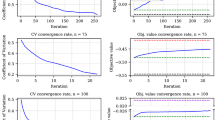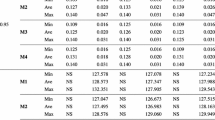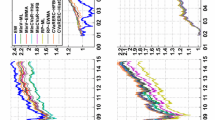Abstract
Risk Parity (RP), also called equally weighted risk contribution, is a recent approach to risk diversification for portfolio selection. RP is based on the principle that the fractions of the capital invested in each asset should be chosen so as to make the total risk contributions of all assets equal among them. We show here that the Risk Parity approach is theoretically dominated by an alternative similar approach that does not actually require equally weighted risk contribution of all assets but only an equal upper bound on all such risks. This alternative approach, called Equal Risk Bounding (ERB), requires the solution of a nonconvex quadratically constrained optimization problem. The ERB approach, while starting from different requirements, turns out to be strictly linked to the RP approach. Indeed, when short selling is allowed, we prove that an ERB portfolio is actually an RP portfolio with minimum variance. When short selling is not allowed, there is a unique RP portfolio and it contains all assets in the market. In this case, the ERB approach might lead to the RP portfolio or it might lead to portfolios with smaller variance that do not contain all assets, and where the risk contributions of each asset included in the portfolio is strictly smaller than in the RP portfolio. We define a new riskiness index for assets that allows to identify those assets that are more likely to be excluded from the ERB portfolio. With these tools we then provide an exact method for small size nonconvex ERB models and a very efficient and accurate heuristic for larger problems of this type. In the case of a common constant pairwise correlation among all assets, a closed form solution to the ERB model is obtained and used to perform a parametric analysis when varying the level of correlation. The practical advantages of the ERB approach over the RP strategy are illustrated with some numerical examples. Computational experience on real-world and on simulated data confirms accuracy and efficiency of our heuristic approach to the ERB model also in comparison with some state-of-the-art local and global optimization codes.



Similar content being viewed by others
Notes
See also http://www.riskparity.com/, http://www.thierry-roncalli.com/riskparity.html, and references therein.
References
Anderson, R.M., Bianchi, S.W., Goldberg, L.R.: Will my risk parity strategy outperform? Financ. Anal. J. 68(6), 75–93 (2012)
Aneja, Y.P., Chandra, R., Gunay, E.: A portfolio approach to estimating the average correlation coefficient for the constant correlation model. J. Financ. 44, 1435–1438 (1989)
Asness, C.S., Frazzini, A., Pedersen, L.H.: Leverage aversion and risk parity. Financ. Anal. J. 68(1), 47–59 (2012)
Bai, X., Scheinberg, K., Tutuncu, R.: Least-squares approach to risk parity in portfolio selection. Quant. Financ. 16, 357–376 (2016)
Bertrand, P., Lapointe, V.: How performance of risk-based strategies is modified by socially responsible investment universe? Int. Rev. Financ. Anal. 38, 175–190 (2015)
Boros, E., Hammer, P.L.: Pseudo-boolean optimization. Discrete. Appl. Math. 123, 155–225 (2002)
Boudt, K., Carl, P., Peterson, B.: Asset allocation with conditional value-at-risk budgets. J. Risk 15, 39–68 (2013)
Cesarone, F., Colucci, S.: Minimum Risk vs. Capital and Risk Diversification strategies for portfolio construction. J. Oper. Res. Soc. SSRN: http://ssrn.com/abstract=2552455 (2015) (submitted)
Cesarone, F., Scozzari, A., Tardella, F.: A new method for mean-variance portfolio optimization with cardinality constraints. Ann. Oper. Res. 205, 213–234 (2013)
Cesarone, F., Scozzari, A., Tardella, F.: Linear vs. quadratic portfolio selection models with hard real-world constraints. Comput. Manage. Sci. 12(3), 345–370 (2015)
Chan-Lau, J.A.: Frontier equity markets: risk parity lessons for asset allocation. J. Altern. Invest 16(4), 28–36 (2014)
Chaves, D., Hsu, J., Li, F., Shakernia, O.: Risk parity portfolio vs. other asset allocation heuristic portfolios. J. Invest. 20(1), 108–118 (2011)
Clarke, R., De Silva, H., Thorley, S.: Risk parity, maximum diversification, and minimum variance: An analytic perspective. J. Portf. Manag. 39(3), 39–53 (2013)
Corkery, M., Cui, C., Grind, K.: Fashionable “risk parity” funds hit hard. Wall Street J. (2013). http://www.wsj.com/articles/SB10001424127887323689204578572050047323638
Dagher, V.: New allocation funds redefine idea of ’balance’. Wall Street J. (2012). http://www.wsj.com/articles/SB10001424052970204542404577158970902886322
DeMiguel, V., Garlappi, L., Uppal, R.: Optimal versus naive diversification: How inefficient is the 1/N portfolio strategy? Rev. Financ. Stud. 22, 1915–1953 (2009)
Elton, E.J., Gruber, M.J.: Estimating the dependence structure of share prices—implications for portfolio selection. J. Financ. 28, 1203–1232 (1973)
Elton, E.J., Gruber, M.J., Padberg, M.W.: Simple criteria for optimal portfolio selection. J. Financ. 31, 1341–1357 (1976)
Elton, E.J., Gruber, M.J., Spitzer, J.: Improved estimates of correlation coefficients and their impact on optimum portfolios. Eur. Financ. Manag. 12, 303–318 (2006)
Lee, W.: Risk-based asset allocation: A new answer to an old question? J. Portf. Manag. 37, 11–12 (2011)
Lohre, H., Opfer, H., Orszag, G.: Diversifying risk parity. J. Risk 16(5), 53–79 (2014)
Maillard, S., Roncalli, T., Teiletche, J.: The properties of equally weighted risk contribution portfolios. J. Portf. Manag. 36, 60–70 (2010)
Pflug, G.C., Pichler, A., Wozabal, D.: The 1/N investment strategy is optimal under high model ambiguity. J. Bank Financ. 36, 410–417 (2012)
Qian, E.: Risk parity and diversification. J. Invest. 20(1), 119–127 (2011)
Qian, E.: Risk parity portfolios: Efficient portfolios through true diversification. Panagora Asset Management, September (2005)
Roncalli, T.: Introduction to Risk Parity and Budgeting. Chapman & Hall/CRC Financial Mathematics Series. CRC Press, Boca Raton, FL (2014)
Scherer, B.: Portfolio Construction and Risk Budgeting, 3rd edn. Risk Books, London (2007)
Sorensen, E.H., Alonso, N.F.: The resale value of risk-parity equity portfolios. J. Portf. Manag. 41, 23–32 (2015)
Spinu, F.: An algorithm for computing risk parity weights. SSRN: http://ssrn.com/abstract=2297383 (July 30, 2013)
Tawarmalani, M., Sahinidis, N.V.: A polyhedral branch-and-cut approach to global optimization. Math. Prog. 103(2), 225–249 (2005)
Acknowledgments
We are grateful to the anonymous reviewers for carefully reading our work and for suggesting several improvements. In particular, one of the reviewers prompted us to extend our original approach for the long-only case to the case where short sellings are allowed.
Author information
Authors and Affiliations
Corresponding author
Electronic supplementary material
Below is the link to the electronic supplementary material.
Rights and permissions
About this article
Cite this article
Cesarone, F., Tardella, F. Equal Risk Bounding is better than Risk Parity for portfolio selection. J Glob Optim 68, 439–461 (2017). https://doi.org/10.1007/s10898-016-0477-6
Received:
Accepted:
Published:
Issue Date:
DOI: https://doi.org/10.1007/s10898-016-0477-6




